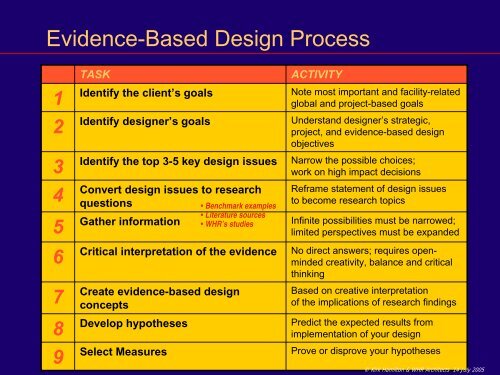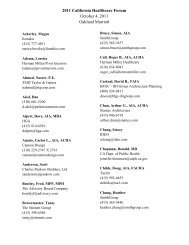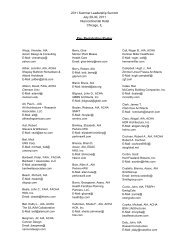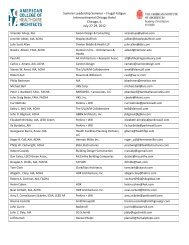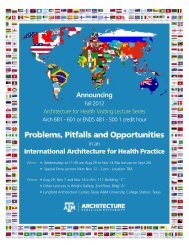Part 2 - Evidence Based Design - American College of Healthcare ...
Part 2 - Evidence Based Design - American College of Healthcare ...
Part 2 - Evidence Based Design - American College of Healthcare ...
You also want an ePaper? Increase the reach of your titles
YUMPU automatically turns print PDFs into web optimized ePapers that Google loves.
<strong>Evidence</strong>-<strong>Based</strong> <strong>Design</strong> Process<br />
TASK<br />
ACTIVITY<br />
1 Identify the client’s goals Note most important and facility-related<br />
global and project-based goals<br />
2 Identify designer’s goals Understand designer’s strategic,<br />
project, and evidence-based design<br />
objectives<br />
3 Identify the top 3-5 key design issues Narrow the possible choices;<br />
work on high impact decisions<br />
4<br />
Convert design issues to research<br />
questions<br />
Reframe statement <strong>of</strong> design issues<br />
to become research topics<br />
5 Gather information • WHR’s studies Infinite possibilities must be narrowed;<br />
limited perspectives must be expanded<br />
6 Critical interpretation <strong>of</strong> the evidence No direct answers; requires openminded<br />
creativity, balance and critical<br />
thinking<br />
7<br />
• Benchmark examples<br />
• Literature sources<br />
Create evidence-based design<br />
concepts<br />
<strong>Based</strong> on creative interpretation<br />
<strong>of</strong> the implications <strong>of</strong> research findings<br />
8 Develop hypotheses Predict the expected results from<br />
implementation <strong>of</strong> your design<br />
9 Select Measures Prove or disprove your hypotheses<br />
Slide: 58<br />
© Kirk Hamilton & WHR Architects 14 July 2005


